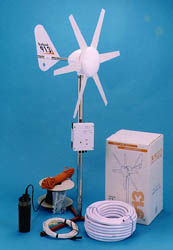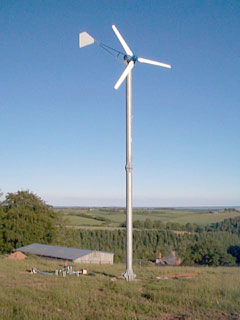|
Wind TurbinesMarlec
Marlec was formed in 1979 by John Fawkes who subsequently received a wind energy pioneer award from the British Wind Energy Association. As an engineer he was asked to investigate methods of keeping batteries topped up on farms to operate electric fence units. The solution was the Rutland Wind charger a simple, reliable and efficient wind driven battery charging generator. Uses for the Rutland quickly diversified and they were soon also seen on ocean going yachts, remote telecommunication sites, static caravans, isolated homes, navigational buoys, clinics in Africa, etc. Marlec has extended its range of wind chargers over the years and has a strong emphasis on product development, continually improving design and performance. In-house manufacturing of generators and other components using our own engineering workshops ensures that quality is carefully controlled and all parts and tooling are made to the highest possible standard. Marlec is proud to be an ISO9001 registered company, one of very few in the renewable energy field internationally. Worldwide there are tens of thousands of satisfied Marlec product users and in some of the earth's most extreme climates ranging from Antarctica to the Sahara Desert. Our quality control and attention to detail along with our innovative flair are without question. Wherever there is a need for power, at any location in the world, Marlec has the solution for independent renewable energy systems
Wind turbine performance specifications are not created equal...... That's because to date there are no firm international standards for how small wind turbines are "rated." Most grid connect wind turbines are given a power specification at 10m/s (meters per second), the equivalent of 22mph or 19Knots. They do of course produce more power in stronger wind speeds. Marlec chooses to rate our wind turbines at this same standard of 10m/s as we believe that as the industry matures a reasonable level such as this one will be established. Manufacturers rating points vary and consequently it is necessary to compare output graphs across a wide band of wind speeds rather than accept individual rating figures for wind turbines. So how much power will a wind charger deliver? The real measure of performance of wind turbines is "accumulated ampere hours" into a battery over a given period of time although this is a difficult measure for manufacturers to express since the users site for the wind charger will affect overall performance. Output graphs are usually an indication of instantaneous peak power at given wind speeds but in real conditions the wind is rarely constant, usually gusting up to 3 or 4 times the average. Wind turbines can theoretically
deliver 4 times the power in twice a given wind speed so calculating
total power generated using average wind speeds is misleading. The Rutland 913 delivers 1.5A @ 10knots, then we could estimate a daily yield of 24hrs x 1.5A = 36Ampere hours. However at the extreme the wind may blow at 20 Knots for 12 hours and be calm for 12hours, showing 10Knots as the average so the potential power generated can be quite different, ie at 20 knots the Rutland 913 delivers 7A, therefore 12hrs x 7A = 84 Ampere hours. The actual accumulated ampere hours in reality is somewhere in the middle demonstrating that average figures can be misleading. This also reinforces the benefit of wind generators that run freely in low winds maximising the available power of the more regular gentle breezes as well as the peaky gusts. Consider the "fill factor" The wind never blows constantly from one direction or at a steady wind speed, it blows in gusts. Most micro wind turbines are fitted with a free yawing mechanism and tail fin to direct the turbine into the wind. Where they differ is in the type of generator and aerofoil blades used which greatly affect their ability to adapt to the changing wind conditions. An unrivalled feature of all the Rutland designs is low wind speed performance. Our high inertia generators maintain momentum and speed between gusts of wind, continuing to generate power where more conventional designs slow down losing power and requiring a strong gust of wind to restart them. This means that overall a Rutland will generate more power into a battery bank in a day when compared to an equally sized or rated turbine and even in cases of generators of a higher "rated" capacity and turbine diameter! See the independent tests on our news pages and compare the turbine diameters to see that you don't always need a larger unit to generate the same or more power. To sum it up: We keep it simple so it's
reliable FORTIS Wind TurbinesCOMPANY PROFILE
FORTIS is the new name for “Renewable Energy” and especially for small wind turbines in the range from 200 Watt to 30 kW rated capacity. These wind turbines can be used for battery charging, water pumping, grid connection, in hybrid systems like wind/diesel and wind/solar, and in many other applications. FORTIS, founded in February 1997, is based on the 16 years experience of Johan Kuikman in Renewable Energy, particularly in small wind turbines. Mr. Kuikman started in 1981 working for LMW Wind Energy as Project Engineer and from 1986 to 1996 as Managing Director. LMW Wind Energy founded at the end of the seventies by Mr. Haavekost, developed and produced small wind turbines for houses without connection to the utility grid or houseboats in the Netherlands and a few European countries. From 1981 onward a number of people from African and Asian countries became increasingly interested in the small battery charging wind turbine, particularly those people working in West European countries whose families were living in North Africa and Asia. During these years Mr. Kuikman acquired a considerable amount of experience for the erection and maintenance of the wind turbine. As service and assistance with installing was practically impossible, an easy to install, maintenance-free wind turbine was essential. With a maintenance free Permanent Magnet brush less generator, reinforced polyester or epoxy rotor blades, voltage control and the hinged tail safety system, the Fortis wind turbines are products, which can be transported and installed with ease. FORTIS will drastically reduce the price of small wind turbines. The prices of small wind turbines produced by well know suppliers are far too high. Projects for developing countries depend fully on AID funds like UNDP and World Bank Private. For solar energy and large wind turbines there are still grants available. Only when the small wind turbines are available against a price, which makes them economic for developing countries, are they competitive against other Renewable Energy sources. The AIM of "FORTIS" The aim of FORTIS is to design and produce wind turbines and other power systems for use in remote and isolated areas. FORTIS is also prepared to make arrangements with well known companies in countries outside Europe for production under licence of FORTIS wind turbines and systems. Fortis can give the required training and support for production as well for marketing and project preparation. PRODUCT DESIGN All FORTIS wind turbines incorporate the following design concept: 1. The wind turbines have low speed permanent magnet alternators for converting the rotational energy of its rotor system (blades) into electricity. The blades drive the rotor of the alternator directly. This rotor rotates in a fixed stator in the alternator. 2. The wind turbines have upwind rotors, and use a tail for alignment into the wind. The rotor axis is offset to one side of the yaw axis so that rotor thrust has the tendency to turn the rotor out of the wind. The tail vane restricts movement of the rotor away from the wind (furling). 3. The generator is coupled directly to the rotor; i.e. no transmission system is required. This results in higher efficiency and lower maintenance costs. 4. The output of the alternator is a rear sinusoidal, variable voltage, variable frequency, three phases AC that is not compatible with battery charging. The voltage control is used to interface the alternator to a battery bank. In other applications such as grid connection and water pumping, a voltage control is needed or a specially built static inverter. The voltage controls are also used in combination with other charging sources (PV modules, diesel generator sets, etc.) 5. The maintenance required for these wind turbines is practically zero. The bearings are greased for the machines' working life. An occasional check to make sure that the bolts have not loosened is the only maintenance required. The working life of the wind turbines is estimated at a minimum of 15 years and an average of 25 years. |


 BACKGROUND
HISTORY
BACKGROUND
HISTORY